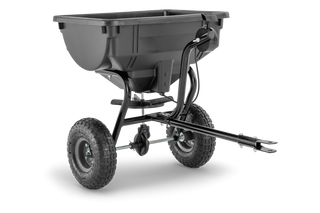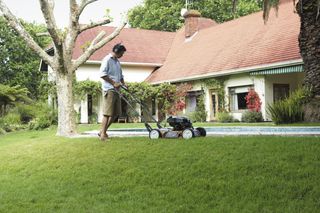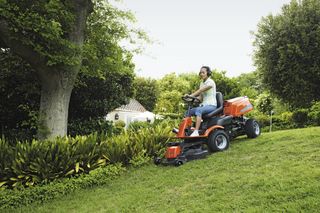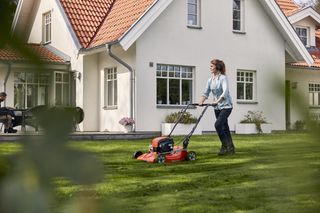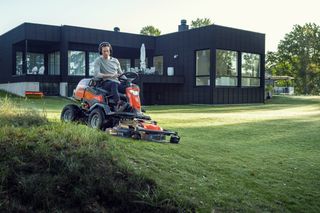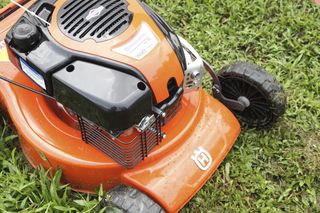How to renovate your lawn and fix patchy grass
A healthy, green, and lush place in your garden, perfect for peaceful relaxation or activities with family and friends – that is what you want your lawn to be, right? But what if dry, brown patches and weed ruin the experience? No need to worry. Here is a step-by-step guide on how to repair a patchy lawn.
| Before you start repairing your lawn |
|---|
| Seeding or turfing? Decide which type of renovation you should go for – new seeds or new turf – by checking how large the damaged part of the lawn is. If less than 40 per cent of it is dead, seeding is sufficient. Why renovate? Try to work out what has caused the lawn to fail. This matters when choosing new seeds and might affect other decisions during renovation. Estimate the effort. Before getting started, try to calculate how large a job you’re facing. Do you need to rent an aerator? Would you like to use a spreader? Should you hire a professional for parts of the work? |
There is a difference between renovating a lawn by adding new seeds and by starting from square one with new turf. If more than 40 per cent of the grass in your lawn has patches, you should go with the latter, but if you are looking at less than 40 per cent of the lawn being damaged or covered with weeds, a good overseeding – that is adding more seeds to your existing grass plants – will be sufficient. In this article, we will focus on renovating your lawn by overseeding.
If we would give you just one piece of advice it is to do a soil test – digging up some soil and sending it to a lab for results. Many homeowners skip this step because they do not know about it. Or because of the cost. But in fact, kicking the renovation off with a soil test is a solid investment.
If you do not analyse the soil, you will never know what it needs to get better. You might end up fertilising over and over without achieving any results. A soil test will tell you what to do, but also what not to do. It provides you with a cost-effective action plan.
How to do a soil test varies in different parts of the world, but commercial labs generally do it. The lab will provide you with a detailed mode of procedure that will be helpful when you move on with your renovation.
1. Decide when to renovate your lawn
Renovation season varies depending on where in the world you live, but the best time to renovate your lawn is when the ground is warm enough for the seeds to germinate and grow. That means that the ground temperature should be at least 10 °C. A good rule of thumb is to wait until after the first cut of the season, when the lawn has turned green and you know that it has started to grow.
2. Determine the reason for lawn failure
If you work out why your lawn has deteriorated, you can use that knowledge to make the right decisions during your renovation. For example, if the lawn has thinned out due to growing trees that shade the lawn and compete for water and nutrients, you should select shade-tolerant grass varieties. You might also want to prune some of the tree limbs, opening up for more sunlight and rainfall.
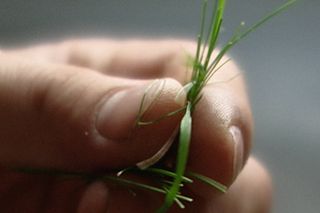
You can get some information by just looking at the lawn, but a proper soil test will give you much better guidance.
3. Remove weeds and thatch
Start the actual renovation by removing weeds – especially the perennial ones – manually or with a herbicide. This keeps other species from competing with your new grass. If you use herbicides, be sure to read the labels and follow the instructions. Most products will allow you to seed in seven days, but some weedkillers will keep your seeds from germinating for three to six weeks.
Check if you need to manage thatch by digging up a small plug of turf, around 10 cm deep. If the spongy layer is more than 2 cm thick when you compress it, it is time to have your lawn dethatched. If your lawn is larger than 300 square meters, you would want to use a power rake or a scarifier. For smaller lawns, a manual thatching rake will do.
4. Prepare the soil
Apart from using it for thatch removal, a vertical mower with a scarifier can be used to prepare the seedbed for new seeds. Go over the entire lawn with the tines set to nick the soil surface to a depth of approximately 0.5 to 1.5 cm and then rake the large clumps of debris from the site. Another way to prepare the soil is to do an extensive aerifying. If you choose this method, you need to go over the entire lawn 3 to 5 times to make it completely aerified. However, the very best result is achieved by doing both of the above: aerification followed by vertical mowing. This will strongly improve water supply to seeds and emerging seedlings.
A common problem is that the soil is too dense or the ground is too hard. That makes it hard for water and oxygen to reach the roots of the grass plants, which leads to poor growth. An aerator creates ways into the soil for the air and water and a vertical mower with a scarifier splits the grass plants, leaving you with more plants and a thicker lawn.
5. Water your lawn
Correct watering of your lawn is essential. Grass seeds and seedlings need water to germinate and root. Your ground does not have to be soggy, but make sure the soil is at least moist. If the lawn feels dry and the chances of rain are low, start building a reserve of water in the soil by running the sprinkler for an hour or two a day several days prior to seeding.
It is important you keep your lawn evenly supported with water. If you do that and the ground temperature is decent, you are well on your way.
6. Use a fertiliser
Fertilisation will encourage establishment and growth of your new seeds and seedlings and should be done just prior to seeding. Apply a slow-release nitrogen fertiliser. If you have done a soil test you will know if your lawn also needs additional phosphorous and potassium.
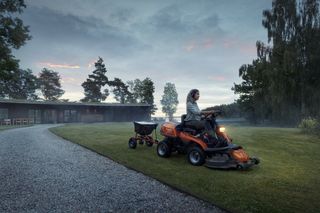
7. Seed
When your lawn is in relatively good condition, you can use the seed mix you used in the past. If you have done a soil test, you will have a good indication of which seeds to use.
You can spread the seeds by hand, but if you want to make sure that the seeds are spread evenly, the best thing to do is to use a spreader. Some spreaders can be connected to your scarifier. In most cases a centrifugal spreader is the best choice.
8. Enjoy
There is no need to wait a certain amount of time before you start enjoying your newly renovated lawn. When you have overseeded it, you can start using it right away, mowing it as you normally would.

